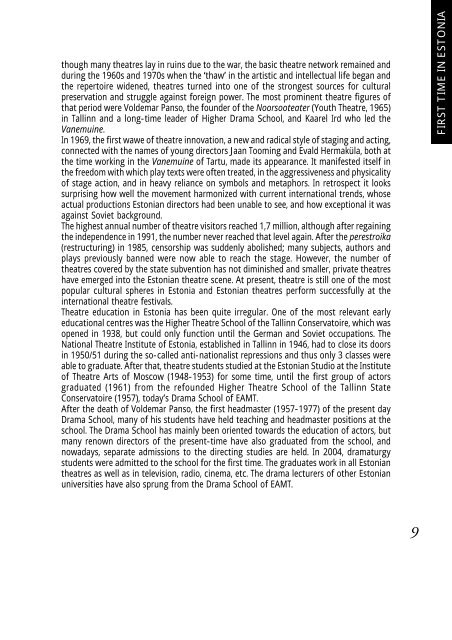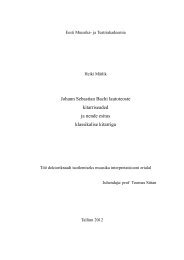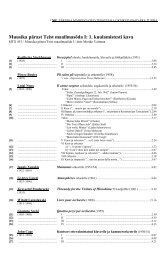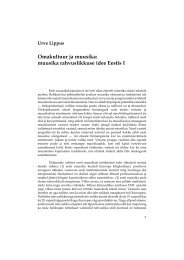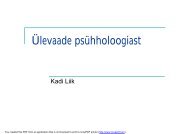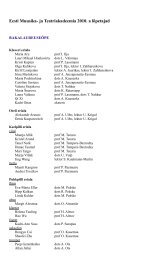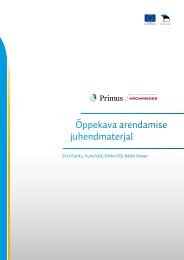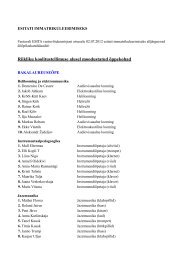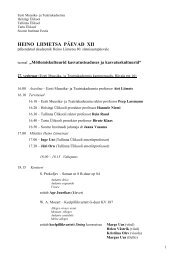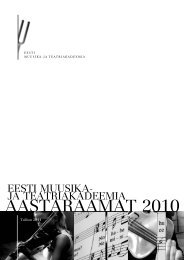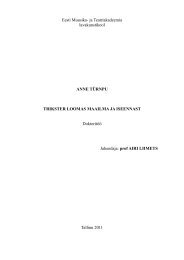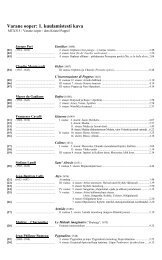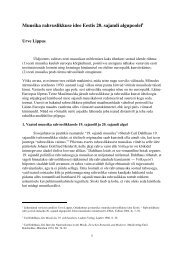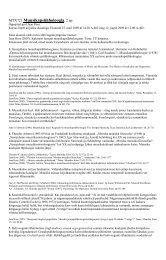You also want an ePaper? Increase the reach of your titles
YUMPU automatically turns print PDFs into web optimized ePapers that Google loves.
though many theatres lay in ruins due to the war, the basic theatre network remained and<br />
during the 1960s and 1970s when the ‘thaw’ in the artistic and intellectual life began and<br />
the repertoire widened, theatres turned into one of the strongest sources for cultural<br />
preservation and struggle against foreign power. The most prominent theatre figures of<br />
that period were Voldemar Panso, the founder of the Noorsooteater (Youth Theatre, 1965)<br />
in Tallinn and a long-time leader of Higher Drama School, and Kaarel Ird who led the<br />
Vanemuine.<br />
In 1969, the first wawe of theatre innovation, a new and radical style of staging and acting,<br />
connected with the names of young directors Jaan Tooming and Evald Hermaküla, both at<br />
the time working in the Vanemuine of Tartu, made its appearance. It manifested itself in<br />
the freedom with which play texts were often treated, in the aggressiveness and physicality<br />
of stage action, and in heavy reliance on symbols and metaphors. In retrospect it looks<br />
surprising how well the movement harmonized with current international trends, whose<br />
actual productions Estonian directors had been unable to see, and how exceptional it was<br />
against Soviet background.<br />
The highest annual number of theatre visitors reached 1,7 million, although after regaining<br />
the independence in 1991, the number never reached that level again. After the perestroika<br />
(restructuring) in 1985, censorship was suddenly abolished; many subjects, authors and<br />
plays previously banned were now able to reach the stage. However, the number of<br />
theatres covered by the state subvention has not diminished and smaller, private theatres<br />
have emerged into the Estonian theatre scene. At present, theatre is still one of the most<br />
popular cultural spheres in Estonia and Estonian theatres perform successfully at the<br />
international theatre festivals.<br />
Theatre education in Estonia has been quite irregular. One of the most relevant early<br />
educational centres was the Higher Theatre School of the Tallinn Conservatoire, which was<br />
opened in 1938, but could only function until the German and Soviet occupations. The<br />
National Theatre Institute of Estonia, established in Tallinn in 1946, had to close its doors<br />
in 1950/51 during the so-called anti-nationalist repressions and thus only 3 classes were<br />
able to graduate. After that, theatre students studied at the Estonian Studio at the Institute<br />
of Theatre Arts of Moscow (1948-1953) for some time, until the first group of actors<br />
graduated (1961) from the refounded Higher Theatre School of the Tallinn State<br />
Conservatoire (1957), today’s Drama School of EAMT.<br />
After the death of Voldemar Panso, the first headmaster (1957-1977) of the present day<br />
Drama School, many of his students have held teaching and headmaster positions at the<br />
school. The Drama School has mainly been oriented towards the education of actors, but<br />
many renown directors of the present-time have also graduated from the school, and<br />
nowadays, separate admissions to the directing studies are held. In 2004, dramaturgy<br />
students were admitted to the school for the first time. The graduates work in all Estonian<br />
theatres as well as in television, radio, cinema, etc. The drama lecturers of other Estonian<br />
universities have also sprung from the Drama School of EAMT.<br />
FIRST TIME IN ESTONIA<br />
9


